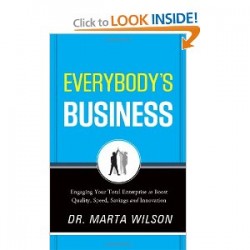
Have you ever wondered how to send a new hire welcome letter to get the employment relationship started on the right foot? I started sending a letter to new hires last year, and I’ve tweaked it over time to cover more questions, beef up explanations, and pretty much share as much information as I possibly can with our new employees. I’ve included my version below, so if you’re considering adding this into your new hire process, feel free to borrow/use some of this. (If you want more help with onboarding and new hire orientation, check out the free new hire orientation eBook!)
The Pinnacle new hire welcome letter
Welcome, [Name]!
We are excited about your first day with Pinnacle. Be forewarned, you’ll have a lot of information thrown at you on the first day, and it probably won’t slow down for a while. A piece of advice: take notes!
We use the phrase “drinking from a fire hose” around here sometimes, and it’s an apt description for the pace of the work we do. Don’t let that worry you, though. Along with that work comes an amazing manager, a supportive team, and a group of leaders that really does care about you and your work.
We’re different from other companies. Other companies say that, but at Pinnacle, it’s true. We are just over four years old and fairly small (about 70 employees at this time). We are growing quickly, and that is as a direct result of our reputation for doing great work. We aren’t a 5,000 person company with dozens of locations. You aren’t a faceless number to us. We treat our people like adults, because you deserve that. We’re a small business doing big things (or “small, but mighty” as we like to put it!).
You have a lot of questions as the resident newbie. Don’t worry, we’ve all been there and it’s understandable. Here are some of the most common questions and answers to get you started. If you have something that isn’t answered below, your supervisor would be happy to assist!
A few things you need to know about your work
- What do I wear? We have a casual atmosphere in the office. It’s business casual most days, and many of us wear jeans on Fridays. Remember, we’re more focused on the work than your clothes!
- Who do I ask questions of if my manager isn’t present? We support each other, so you can get questions answered by anyone. The most common questions can go to [insert operations team description/focus areas].
- What do I do if I have a computer problem? Send an email to [support address] describing your problem to open a trouble ticket.
- What are the standard working hours? With your key, you can get into the building 24/7 if necessary. Some of the engineers work 6:00-3:00. Some of the operations staff work 8:00-5:00. Find something that is comfortable with you and communicate that with your supervisor.
- Will I have to work overtime? Evenings? Weekends? At times we will have flurries of activity that require some overtime, but it’s not a regular/weekly occurrence.
- Will I have to travel? How often? Who makes travel arrangements? Travel isn’t something we do often, but it’s not unheard of. If you are required to travel, speak with your manager about who is responsible for making your travel arrangements.
- How flexible are my work hours? One thing we appreciate at Pinnacle is the person you are outside of work. We work hard to be flexible when work and life events conflict. During those times stay in close communication with your manager if possible. It’s more about fitting your work into your life than the other way around.
A few things you need to know about your department
- Who will I be working with? First and foremost, you’ll be working closely with your manager. They will be able to answer most of your questions or point you in the right direction if they cannot. The rest of your team will be [short description of department].
- Who are the “movers and shakers” in the organization and how can I become one of them? The neat part about Pinnacle is that we all have our unique roles and responsibilities, and we all have a time and place for to be the “mover and shaker.” Doing your work well is a surefire way to establish your credibility as a foundation for future professional and organizational growth.
- If I have ideas, suggestions or concerns, what channels exist to share those concerns? If it’s an idea, we have a Big Ideas database on SharePoint that you can use as an outlet for sharing new, innovative ideas. If you have concerns, your manager or theirs will be the next likely step.
- How do people prefer to communicate in this organization? (Face to face? By e-mail? Phone?) Depending on the topic, we use all of these methods. Inside the office, we use Windows Messenger chats for quick back-and-forth conversations. Because we have locations across the US, we use email to do much of our official communication. Phones are perfectly acceptable when you need a quick answer and email isn’t fast enough. And face-to-face conversations (or “huddles,” as we like to call them) are key to solving many of the issues we run into on a daily basis.
A few things you need to know about Pinnacle
- Do we have a strategic plan? What does it entail? The strategic goals of the organization are developed and shared on an annual basis by the Leadership Team. The corporate goals/strategy for 2012:
- What are employees rewarded and recognized for? As previously stated, doing your work well is the best way to go. It sounds simplistic, but many organizations don’t have the transparency and flatness of Pinnacle. You interact on a daily basis with everyone from the CEO to a customer site lead to the engineers at corporate. They can tell when you are doing your work well, and good news like that travels quickly.
Questions?Â
———–
Again, this is just one piece of a new hire process that touches on our culture in multiple ways. Anyone else use a similar tool with new hires? Care to share what sort of content you cover in this “welcome” document? Here’s an example of one of the welcome letters to new employees that has stuck in my mind for years.



